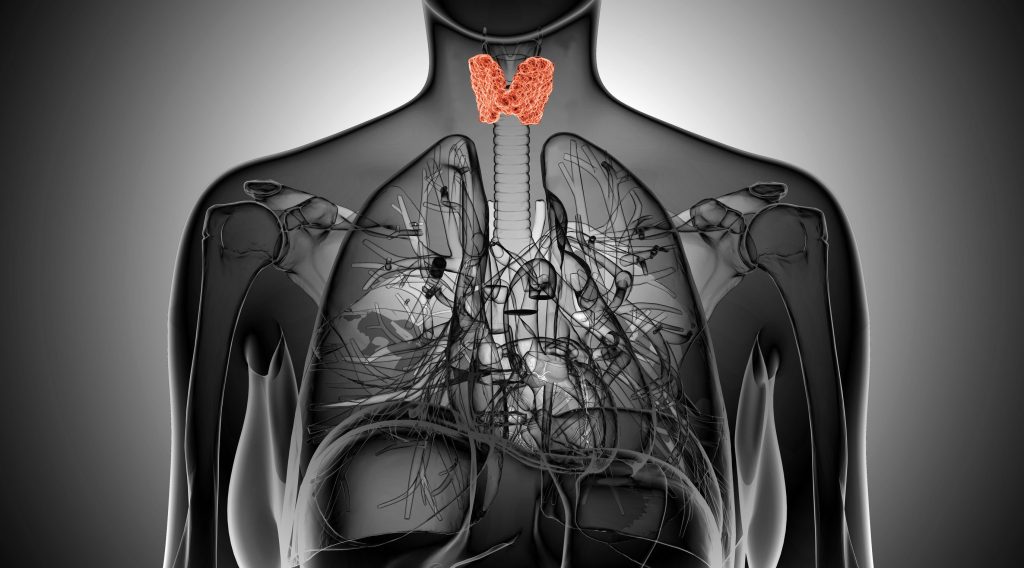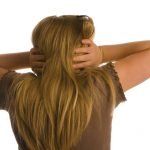Docere
Heather Herington, BSc, NMD, DHANP
There’s nothing like having your own “incurable” disease to sense the impact of naturopathic medicine, especially when you – a naturopathic doctor – have been taught to not treat it. You figure there has to be more to that story. At the time, although feeling great and with labs balanced, I wondered how long it would last. Would I need to move away from Los Angeles to heal from autoimmune hyperthyroidism?
It took me 2 bouts, 5 years apart, to fully understand the disease and clearly see the fault lines in the allopathic “slash or burn” approach that is still the norm. I learned, in the course of my healing, that Graves’ disease is an autoimmune disorder with a psychological disturbance at its core. I also discovered the powerful role of the expressive arts in the healing of Graves’ disease. Without singing, I don’t believe me and my gal (read: thyroid) would be on such good terms right now.
My hope is that this article will inspire and empower you to treat your next patient with autoimmune hyperthyroidism rather than automatically refer out. If I was able to turn this around, others can too.
Graves’ Disease: A Brief Review
A few days after my initial diagnosis of hyperthyroidism, I was sitting in my gastroenterologist brother’s office, first weeping from despair and insomnia, and then shaking my head and almost laughing when he listed my options for dealing with an undetectable TSH (thyroid-stimulating hormone). A few days later, an integrative physician confirmed that I must pursue conventional options. Now I was really trembling, not from the “hyperness” of a fast pulse, but from the fear of losing my thyroid.
The conventional approach involves a combination of anti-thyroid medications (propylthiouracil or methimazole), beta-blockers (to control symptoms), and either thyroidectomy (complete or subtotal) or radioactive iodine to shrink the gland. Anti-thyroid meds are usually necessary in the acute stage but can take 3-6 weeks to work. I am vehemently opposed to thyroidectomy or surgery, as either procedure risks damaging vocal cords and parathyroid glands. Radioactive iodine therapy gradually reduces hyperthyroid symptoms but results in lifelong hormone replacement. It doesn’t have to be that way.
Thankfully, I discovered an older, European-trained endocrinologist who was open to avoiding the allopathic standard. He seemed to be of the same mind as Graves’ expert, Elaine Moore: “There’s no rush.”1 (Really? My resting pulse was over 100.)
I called Bastyr, my alma mater, and learned their directive had not wavered: Refer hyperthyroidism, as it’s too dangerous for a naturopathic doctor to treat. Feeling reluctant to go the allopathic route, the phrase, “The doctor who has herself for a patient is a fool,” ran through my head.
In naturopathic medicine we take a deeper dive and search for the underlying causes of the misdirected immune response and inflammation. Common areas of focus include the GI tract (eg, leaky gut, dysbiosis, and pathogens),2 oxidative stress,3 and toxins.
I was already detoxing regularly and eating impeccably. I knew I had to look further to stop my growing anxiety, a racing pulse, and sleeplessness. But what more did I need to know? Like any other organ, the thyroid doesn’t work alone; to compartmentalize and isolate it seemed absurd. The phrase, “It takes a village,” came to mind.
“Thyroid gland function is one of the most misunderstood systems by conventional medical doctors,” wrote Erin Lommen, ND, and Jay Mead, MD, in their book, Slim, Sane and Sexy.4 “Regaining full thyroid function requires a willingness to strive for optimal hormone levels rather than normal levels.” I translated this as a willingness to strive for optimal health using a whole-person approach.
But what were the particular roots of this inflammatory process? Was it an allergy, a mineral deficiency, environmental toxins? I certainly had exhausted adrenal glands, and I was almost to the point of acknowledging unfettered emotion.
Symptoms & Complications of Graves’ Dz
The thyroid gland is no wilting violet in its healthy state. It is the master regulator of the body, giving direction to every cell and organ. It affects not only protein and carbohydrate metabolism, body weight, heart rate, blood pressure, sleep, and sexual response; it also influences well-being, particularly cognitive function and mood stability.
The physical manifestations of Graves’ disease are clear. In its hyper state, the thyroid accelerates the metabolic rate. The disease process usually starts slowly with mild symptoms, such as an inability to relax, irritability, heat intolerance, difficulty sleeping, and a fast pulse. These warning signs can expand to include an even-faster resting pulse, severe weight loss, increased perspiration and bowel movements, hand tremors, low libido, dry and brittle hair, changes in menstrual flow, tinnitus, a goiter, and, eventually, brittle bones. Graves’ dermopathy manifests as thick, orange-peel-like skin on the shins, tops of the feet, or elsewhere.4 Almost half of people with Graves’ disease develop ophthalmopathy, or orbitopathy.5 As antibodies attack and inflame the soft tissue behind the eyeball, hyperplasia occurs, pushing the eyeball forward. Left untreated, complications of Graves’ can include cardiac arrhythmias, changes in heart muscle structure and function, heart failure, and blindness.6 In pregnancy, Graves’ disease carries the threat of miscarriage, preeclampsia, fetal thyroid dysfunction, and poor fetal growth.6
Although rare, the most serious complication is thyroid storm.7 Life-threatening, this event requires immediate emergency care. Symptoms such as fever, profuse sweating, vomiting, diarrhea, severe weakness, seizures, a markedly irregular heartbeat, yellow skin and eyes, and severe hypotension that can lead to coma combine to make this event out of the range of naturopathic physicians.
The Search for Clues
Despite the dangers, I persevered. While I calmed myself in a variety of ways – eg, meditation, slow walks, homeopathy, Chinese herbs, acupuncture, massage, and (for my husband’s sake) a tiny bit (5 mg) of methimazole, which I shaved down to nothing over 2 months – I looked more deeply into my situation. I was determined to put my finger on what I needed to understand to heal a disease I was taught not to treat.
I re-read the risk factors. I was female but no longer under 40, not pregnant, had no family history, had no other autoimmune diseases, didn’t smoke, and had no physical stress. I had emotional stress from grief, but I was handling that. Wasn’t I?
Before delving into that hornet’s nest, I reviewed the feedback loop from the hypothalamus (thyroid-releasing hormone, or TRH), to the pituitary gland (TSH) and, finally, the thyroid (T3, T4). I remembered that the hypothalamus responds to stress – a strong emotion. Ditto the pituitary.
Role of the Emotional Body
Leaning into the past, I learned that this constellation of symptoms was first described in 1786 by Dr Caleb Parry in England, 25 years earlier than Dr Robert Graves in Ireland. In 1835, Dr Graves noted the cause: “…a bereavement following the death of a loved one, a marital breakup, major financial concerns … an overwhelming grief, an upset.”8 He spoke of a sense of doom – something I increasingly related to over time as denial of my emotional state waned. I felt deeply indebted to these doctors for their observations, a discussion that never entered the room with any of my medical doctors. Not one of them mentioned stress, let alone grief, to me. Not one even suggested I see someone for anxiety. It was just part of the symptom package that would be healed through one caustic method or another.
This malady of omission is, of course, rampant, even though medical professionals have emerged in the last century to voice the role of emotions and stress as a cause of illness, particularly Hans Selye, MD, who came to the conclusion in the 1950s that 7 distinct conditions, including Graves’ disease, have an underlying cause of stress. So why does it continue to be ignored?
The observations of Dr Graves and Dr Perry gave me the incentive to probe my own grief and release feelings in order to heal. I accepted that my personal narrative had been the origin of my illness, or had at least played a large role in it. I had already witnessed this in my patients over the years – the linking up of physical complaints with grief and trauma, including sexual abuse and addiction. Once this connection was made, and patients were able to track the cause through active listening, visualization, simple witnessing, and/or creative expression, symptoms would disappear. It didn’t matter what the physical presentation was; something would change, often dramatically. This is true holism – to explore the whole picture, the whole person.
The trauma in Graves’ may be more sudden and more apparent as the body goes into overdrive to deal with the shock of a profound upset; however, I believe our commitment to Tolle causam and Vis medicatrix naturae is exactly what people suffering autoimmune hyperthyroidism need. This is not to say that pharmaceuticals aren’t necessary, especially at the start; it depends on the severity of the disease. And it doesn’t mean you have to be directly involved in emotional therapy or know anything about the expressive arts. Just be aware of this possible central core, and refer out if need be.
Effects of the Physical Body
And with all that being said, the opposite can also be true: the physical affects the psychological. Graves’ disease may cause increased adrenergic responsiveness, which acknowledges the role of the adrenal glands.9 This can occur as part of a concerted physiological response to a shock or grief. Undoubtedly, there is much our medicine can address without necessarily nailing an initial psychological event. For instance, how much do endocrine disruptors affect the thyroid? What is the outcome when essential minerals are displaced in our metabolic processes? What roles do environmental and food allergies, or vitamin D, B12, and other micronutrients, play in hyperthyroidism? What about viruses or bacteria? One theory posits that antibodies to Yersinia can cause autoimmune thyroid disease.10
The need for a healthy liver is obvious, given its role in activating thyroid hormone and producing the binding globulin that carries T4 and T3 to tissues. We also know that estrogen dominance can increase concentrations of free T4. And inflammation exacerbates autoimmunity. I have often wondered at my “luck” at escaping protruding eyes. Was this because I’ve eaten an anti-inflammatory diet since my teens?
Normalizing the pulse and thyroid function may not be possible without restoring gut function, optimizing the microbiome, detoxifying the liver, managing cortisol levels, and regulating blood sugar. But also addressing psychological contributors seems essential for cure.
On the Path to Healing
It took me 2 tries to finally get well. The first time, my thyroid normalized after 3 months of an integrative approach that included, among other agents, a low dose of tapazole (shaved down to nothing over 3 months) and Chinese herbs. I had become hypothyroid over time, as expected, and was taking dessicated thyroid. I was fine for a year, and then symptoms of edginess returned. This time, it took me 6 months to get well. That was 5 years ago, and my hyperthyroidism has not returned.
Both times I used a broad-spectrum naturopathic approach (see Table 1). But it was only after the second bout that I discovered the extraordinary power of the expressive arts in treating the emotional body. In part, I attribute my ability to heal to daily singing. This is why a 2-pronged approach is so important: first balance the biochemistry, and then investigate and have the patient express any unresolved psychological trauma.
I agree with the writer, Dharam Barrett, who says “Most thyroid disease occurs in sensitive people who strongly experience everything that happens to them, those who get deeply hurt with the bad behavior of other people…negative emotions remain frozen in the body, they are collected in the thyroid gland, and then it comes to thyroid disorders often leading to life claiming diseases such as cancer.”11
Maya Rogers – a singer, composer, and educator who healed her traumatic brain injury through singing – writes, “When we allow ourselves the joy of self-expression through our voices, it awakens parts of us that may have been dormant or neglected our entire lives. We gain access to a deep inner wisdom, and with this wisdom comes transformative power.”12
And a Russian doctor, Oler Torsunov, MD, encourages anyone with a thyroid issue to sing. “Sing,” he writes. “Singing will help the thyroid gland get rid of the negative emotions that are stuck in it. The nodules in the thyroid gland will disappear by themselves. Sing happy songs, no matter what kind of problems you have.”
My husband and I are both musical, so some form of music is always present in our house. I had always danced in the mornings, but I started singing more to conserve my energy. I noticed after my second bout that I felt worse when I didn’t sing, and better when I did.
In a Time Magazine article, Stacy Horn writes, “What researchers are beginning to discover is that singing is like an infusion of the perfect tranquilizer, the kind that both soothes your nerves and elevates your spirits.”13
This is exactly what sufferers of Graves’ disease need as they incorporate new habits of health, including identifying and healing the emotional body.
Table 1. Some Treatment Tips for Graves’ Disease
| Foods | Millet: Rich in C-glycosylflavones; has anti-thyroid effects similar to anti-thyroid medications like tapazole15
Goitrogenic crucifers, preferably raw: kale, cauliflower, broccoli, Brussels sprouts. Soy and peanuts are suggested as well, but have mild activity and there may be other reasons to avoid them. Fermented forms such as tempeh and miso are OK.
A low-carb, gluten-free diet may help prevent the development of ophthalmopathy in Graves’ patients16 |
| Minerals | Selenium, zinc, and others, as you would also consider in hypothyroidism
Iodine: Essential for thyroid hormone production, thus important to include, at least once thyroid levels have normalized. (I now consume 6.25 mg QOD iodine, as well as phytoplankton.) Iodine can be used to suppress a hyperthyroid state; however, this treatment is controversial and more research is needed for definitive guidelines. I opted for no iodine while hyperthyroid. |
| Modified Citrus Pectin | Has anti-inflammatory properties due to its inhibition of the carbohydrate-binding lectin, galectin-317; it also supports a healthy microbiome. Start with 5 mg/d. |
| Botanicals18 | Leonorus cardiaca (motherwort) and Lycopus virginicus (bugleweed) are anti-thyroid, less powerful than synthetic drugs, but adequate in less severe cases. Can require 3-4 wk to produce a noticeable difference. Leonorus also relieves palpitations and tachycardia.
Melissa officinalis (lemon balm): Sedative, also anti-viral, which might help in Graves’
Valeriana: Increases GABA
Cannabis sativa (as CBD oil): 1 mL/d=50 mg – standard dose, but everyone is different. The endocannabinoid system is abundant in thyroid tissue.19
Chinese herbs (and acupuncture): Certain hyperthyroid formulas are rooted in thousands of years of experience, even if the doctors didn’t call it hyperthyroidism. This helped me at the start of my journey with Graves’, but I am not trained in TCM. |
| Homeopathy | For non-homeopaths, start with Iodum 30C 1-2 times daily until a constitutional case can be taken (mine was Argentum nitricum) |
| Hydrotherapy | Cold immersion only (eg, in lake or pool), at least in the initial stages of the disease |
| Mind-Body Practices | Mind-Body practices help engage the parasympathetic nervous system!
· Meditation · Breath work (eg, 4 in-breaths to 8 out-breaths) · Visualization, hypnosis, tracking, or other psychoneuroimmunology technique, to address an unconscious cause of disease · Gentle exercise (eg, swimming, walking) · Sound healing (eg, binaural beats, Tibetan bowls/bells, humming, chanting) |
| Expressive Arts |
Explore the patient’s story through writing, color, movement, and drama. Encourage laughter and joy. · SING! – Singing (like humming and chanting) activates the fifth chakra; increases oxygenation (thereby improving the thyroid gland); and promotes feelings of happiness and well-being |
Conclusion
I believe allopathic medicine’s refusal to investigate underlying proclivities warrants naturopathic physicians and educators taking a much larger role in this sometimes life-threatening disease. We can do much to alleviate suffering from this disease and to save people from the standard treatments that seem barbaric and out of touch.
Graves’ disease clearly lends itself to a holistic approach. Grief being at its root underscores both the mind-body connection and the need for more research to understand the possible causes, including trauma and environmental toxicity. It also highlights the need to augment our education with tools to probe an emotional root through the expressive arts.
It became clear to me that Graves’ disease results from trauma and most likely features the same neural disturbance as PTSD: an overexcited amygdala, an underperforming prefrontal cortex, and hippocampus involvement. Research studies are needed, not just anecdotes, to demonstrate the effects on the brain of music and other expressive arts, particularly the creation of new hippocampal neurons.14 Can writing, art, dance, and singing impact a disease as serious as Graves’? This research is way overdue.
Once the underlying psychological and physical forces are evident, Graves’ disease is no longer scary. A holistic treatment plan can utilize the full spectrum of the modality arc, from temporary anti-thyroid medication to the expressive arts, putting this “incurable” disease on its way to being understood and healed. Remember, the thyroid gland is just doing its best to handle what’s being thrown its way. Help it out the best you know how.
Table 2. Laboratory Guidelines
|
Biomarker |
Recommendations |
| TSH
(serum) |
In hyperthyroidism, the TSH is barely detectable (in my case <0.004), telling the thyroid to slow down because of excessive T4 and T3. The conventional TSH range has been 0.5 to 5.5 mcg/dL, but many endocrinologists now recommend 0.3 to 3.0; 1 to 2 may be optimal. |
| Free T3 & T4
(serum) |
The metabolically active form of thyroid hormones. Optimal ranges for free T3 and T4 are 3-4 pg/mL and 1-1.5 ng/dL respectively. (Total T3 and T4 can be omitted.) |
| TPO Antibodies
(serum) |
The TPO enzyme catalyzes the oxidation of iodide on tyrosine residues in thyroglobulin, for the synthesis of T3 and T4. Is the most sensitive test for determining autoimmune thyroid disease, whether Graves’ or Hashimoto’s, although not definitive for the type (5-10% of healthy people test positive for TPO). Only 60 to 80% of patients will have them, although some authors list up to 95%.20,21 Normal = <4 IU/mL. |
| TSH-R Antibodies
(serum) |
TSH receptor antibodies are not found in healthy individuals, so their presence indicates autoimmunity. Is a hallmark of Graves’ disease, although is also positive in 10-15% of people with Hashimoto’s.22 |
| TSI
(serum) |
Thyroid-stimulating immunoglobulins bind to tissues in the eyeballs and beneath the skin, contributing to exophthalmos and pretibial myxedema. Elevated TSI level is associated with the development of Graves’ ophthalmopathy/orbitopathy.23 Imaging tests, CT scans and/or MRI are needed, so this is for information only. |
| Additional Tests | · Adrenal function test (saliva). Four measurements of cortisol over 24 hr are essential. Remember, the thyroid dances with the adrenals.
· E1, E2, E3, and Progesterone (saliva or urine) · Miscellaneous others: liver function, heavy metals, mineral status |
(TSH = thyroid-stimulating hormone; T3 = triiodothyronine; T4 = thyroxine; TPO = thyroid peroxidase; TSHR = thyrotropin receptor; TSI = thyroid-stimulating immunoglobulin; E1 = estrone; E2 = estradiol; E3 = estriol)
Note: Be aware that thyroid lab values often change yearly. Work with a trusted lab.
References:
- Moore EA, Moore L. Graves’ Disease: A Practical Guide. Jefferson, NC: McFarland; 2001.
- Eliaz I. Survival, Harmony and the Microbiome. [Presentation]. May 14, 2019; Santa Monica, CA.
- Mancini A et al. Thyroid Hormones, Oxidative Stress, and Inflammation. Mediators Inflamm. 2016;2016:6757154.
- Mead JH, Lommen ET. Slim, Sane & Sexy. Oregon City, OR: Calaroga Publishing; 2008.
- Bahn RS. Graves’ ophthalmopathy. N Engl J Med. 2010;362(8):726-738.
- Girgis CM, Champion BL, Wall JR. Current concepts in graves’ disease. Ther Adv Endocrinol Metab. 2011;2(3):135-144.
- Carroll R, Matfin G. Endocrine and metabolic emergencies: thyroid storm. Ther Adv Endocrinol Metab. 2010;1(3):139-145.
- Graves RJ. Clinical lectures. London Med Surg J. 1835;7:516-517.
- Bilezikian JP, Loeb JN. The influence of hyperthyroidism and hypothyroidism on alpha- and beta-adrenergic receptor systems and adrenergic responsiveness. Endocr Rev. 1983;4(4):378-388.
- Corapçioğlu D, Tonyukuk V, Kiyan M, et al. Relationship between thyroid autoimmunity and Yersinia enterocolitica antibodies. Thyroid. 2002;12(7):613-617.
- Barrett D. How Singing Can Help Heal Thyroid Disease. January 22, 2016. I Heart Intelligence. Available at: http://iheartintelligence.com/2016/01/22/singing-thyroid-disease/. Accessed May 12, 2019.
- Rogers M. The Healing Power of Your Voice: 7 Reasons Why Everyone Should Sing. August 10, 2015. DIY Musician. Available at: https://diymusician.cdbaby.com/musician-tips/the-healing-power-of-your-voice-7-reasons-why-everyone-should-sing/. Accessed May 12, 2019.
- Horn S. Singing Changes Your Brain. August 16, 2013. Time Magazine. Available at: http://ideas.time.com/2013/08/16/singing-changes-your-brain/. Accessed May 12, 2019.
- Herdener M, Esposito F, di Salle F, et al. Musical training induces functional plasticity in human hippocampus. J Neurosci. 2010;30(4):1377-1384.
- Gaitan E, Lindsay RH, Reichert RD, et al. Antithyroid and goitrogenic effects of millet: role of C-glycosylflavones. J Clin Endocrinol Metab. 1989;68(4):707-714.
- Alternative to surgery for Graves’ eye disease: Low-carb, gluten-free diet may help. July 9, 2014. Loyola University Health System. ScienceDaily Web site. https://www.sciencedaily.com/releases/2014/07/140709151533.htm. Accessed July 10, 2019.
- Henderson NC, Sethi T. The regulation of inflammation by galectin-3. Immunol Rev. 2009;230(1):160-171.
- Duke JA. The Green Pharmacy: The Ultimate Compendium Of Natural Remedies From The World’s Foremost Authority On Healing Herbs. New York, NY: St. Martin’s Press; 1998.
- Borowska M, Czarnywojtek A, Sawicka-Gutaj N, et al. The effects of cannabinoids on the endocrine system. Endokrynol Pol. 2018;69(6):705-719.
- Fröhlich E, Wahl R. Thyroid Autoimmunity: Role of Anti-thyroid Antibodies in Thyroid and Extra-Thyroidal Diseases. Front Immunol. 2017;8:521.
- De Groot LJ. Graves’ Disease and the Manifestations of Thyrotoxicosis. Last updated April 20, 2015. Available at: https://pdfs.semanticscholar.org/5ed4/f41f9131f17ef9f03f1835b2d30b77316b4b.pdf. Accessed July 10, 2019.
- Michalek K, Morshed SA, Latif R, Davies TF. TSH receptor autoantibodies. Autoimmun Rev. 2009;9(2):113-116.
- Acuna OM, Athannassaki I, Paysse EA. Association between thyroid-stimulating immunoglobulin levels and ocular findings in pediatric patients with Graves disease. Trans Am Ophthalmol Soc. 2007;105:146-150; discussion 150-151.

Heather Herington, BSc, NMD, DHANP, was a 1987 grad of Bastyr when it was called John Bastyr College of Naturopathic Medicine. Dr Heather has treated PTSD, addiction, and autoimmune diseases for over 30 years. She was delighted that David Schleich, PhD, wrote the preface to her upcoming book, Transforming Trauma: A drugless and creative approach to healing PTSD and other conditions with trauma at the root. See drheatherherington.com for her 1-act radio play, Dr. Graves, We Can Heal Your Disease. For speaking engagements and training (workshops and retreats) for health and non–health professionals, including lawyers, please email [email protected]. Phone: (818) 307–6368





